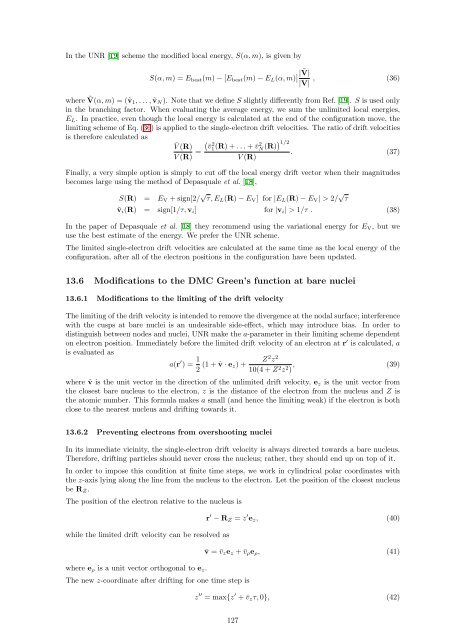CASINO manual - Theory of Condensed Matter
CASINO manual - Theory of Condensed Matter
CASINO manual - Theory of Condensed Matter
Create successful ePaper yourself
Turn your PDF publications into a flip-book with our unique Google optimized e-Paper software.
In the UNR [19] scheme the modified local energy, S(α, m), is given by<br />
S(α, m) = E best (m) − [E best (m) − E L (α, m)] |Ṽ|<br />
|V| , (36)<br />
where Ṽ(α, m) = (ṽ 1, . . . , ṽ N ). Note that we define S slightly differently from Ref. [19]. S is used only<br />
in the branching factor. When evaluating the average energy, we sum the unlimited local energies,<br />
E L . In practice, even though the local energy is calculated at the end <strong>of</strong> the configuration move, the<br />
limiting scheme <strong>of</strong> Eq. (36) is applied to the single-electron drift velocities. The ratio <strong>of</strong> drift velocities<br />
is therefore calculated as<br />
2 ¯V (R)<br />
(¯v<br />
V (R) = 1 (R) + . . . + ¯v N 2 (R)) 1/2<br />
. (37)<br />
V (R)<br />
Finally, a very simple option is simply to cut <strong>of</strong>f the local energy drift vector when their magnitudes<br />
becomes large using the method <strong>of</strong> Depasquale et al. [18],<br />
S(R) = E V + sign[2/ √ τ, E L (R) − E V ] for |E L (R) − E V | > 2/ √ τ<br />
ṽ i (R) = sign[1/τ, v i ] for |v i | > 1/τ . (38)<br />
In the paper <strong>of</strong> Depasquale et al. [18] they recommend using the variational energy for E V , but we<br />
use the best estimate <strong>of</strong> the energy. We prefer the UNR scheme.<br />
The limited single-electron drift velocities are calculated at the same time as the local energy <strong>of</strong> the<br />
configuration, after all <strong>of</strong> the electron positions in the configuration have been updated.<br />
13.6 Modifications to the DMC Green’s function at bare nuclei<br />
13.6.1 Modifications to the limiting <strong>of</strong> the drift velocity<br />
The limiting <strong>of</strong> the drift velocity is intended to remove the divergence at the nodal surface; interference<br />
with the cusps at bare nuclei is an undesirable side-effect, which may introduce bias. In order to<br />
distinguish between nodes and nuclei, UNR make the a-parameter in their limiting scheme dependent<br />
on electron position. Immediately before the limited drift velocity <strong>of</strong> an electron at r ′ is calculated, a<br />
is evaluated as<br />
a(r ′ ) = 1 2 (1 + ˆv · e Z 2 z 2<br />
z) +<br />
10(4 + Z 2 z 2 ) , (39)<br />
where ˆv is the unit vector in the direction <strong>of</strong> the unlimited drift velocity, e z is the unit vector from<br />
the closest bare nucleus to the electron, z is the distance <strong>of</strong> the electron from the nucleus and Z is<br />
the atomic number. This formula makes a small (and hence the limiting weak) if the electron is both<br />
close to the nearest nucleus and drifting towards it.<br />
13.6.2 Preventing electrons from overshooting nuclei<br />
In its immediate vicinity, the single-electron drift velocity is always directed towards a bare nucleus.<br />
Therefore, drifting particles should never cross the nucleus; rather, they should end up on top <strong>of</strong> it.<br />
In order to impose this condition at finite time steps, we work in cylindrical polar coordinates with<br />
the z-axis lying along the line from the nucleus to the electron. Let the position <strong>of</strong> the closest nucleus<br />
be R Z .<br />
The position <strong>of</strong> the electron relative to the nucleus is<br />
while the limited drift velocity can be resolved as<br />
where e ρ is a unit vector orthogonal to e z .<br />
The new z-coordinate after drifting for one time step is<br />
r ′ − R Z = z ′ e z , (40)<br />
¯v = ¯v z e z + ¯v ρ e ρ , (41)<br />
z ′′ = max{z ′ + ¯v z τ, 0}, (42)<br />
127

















